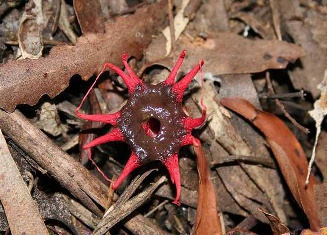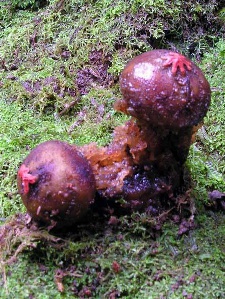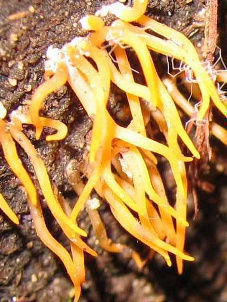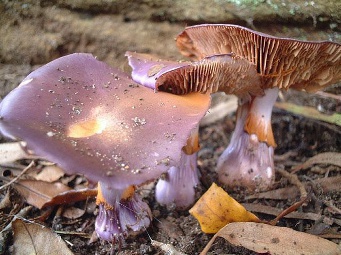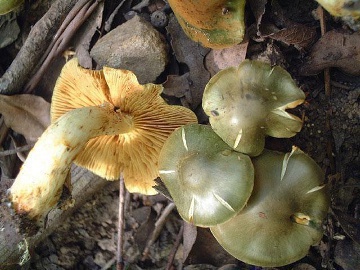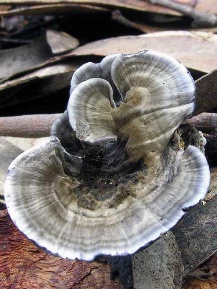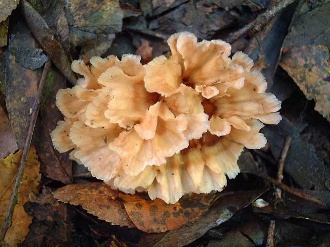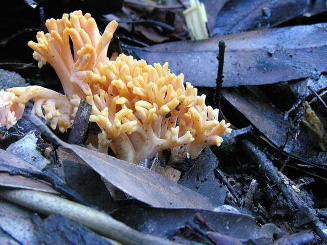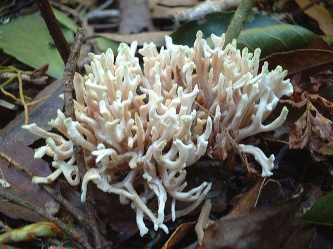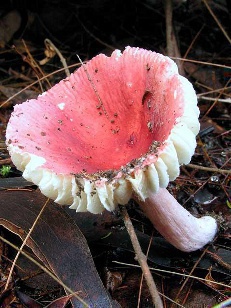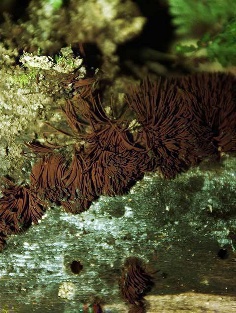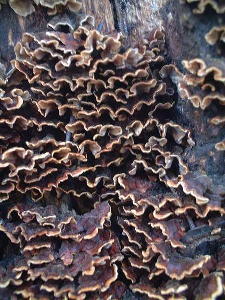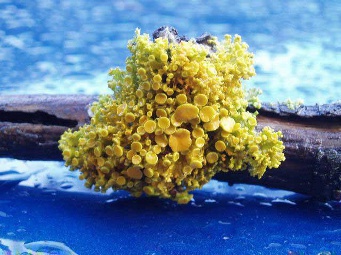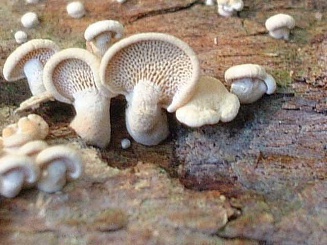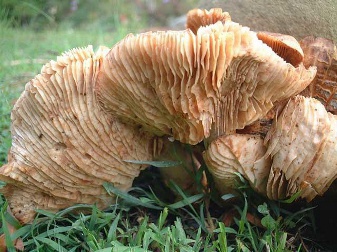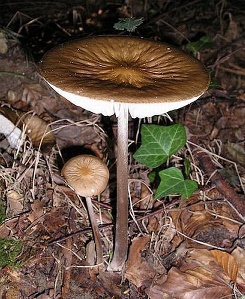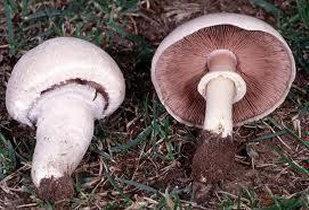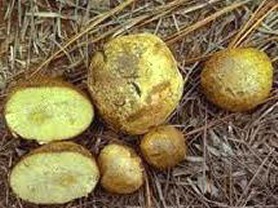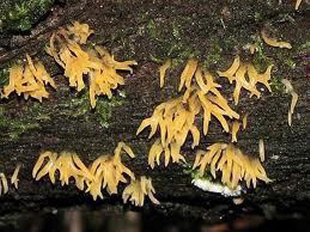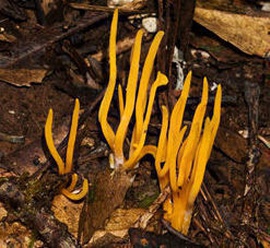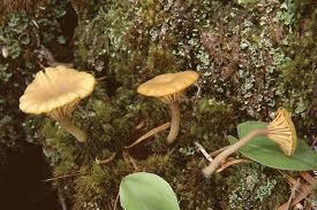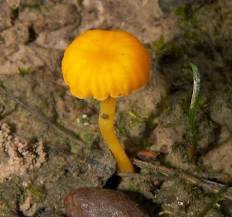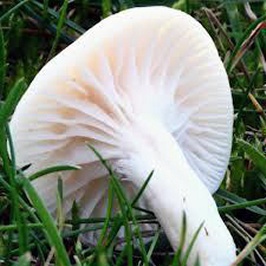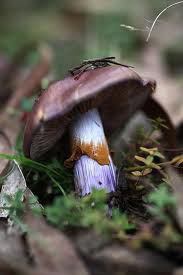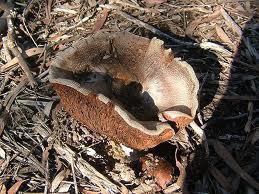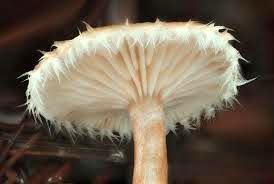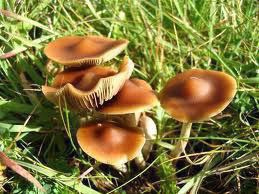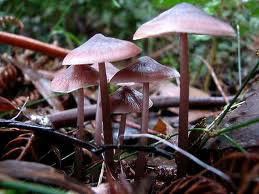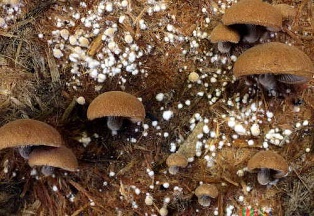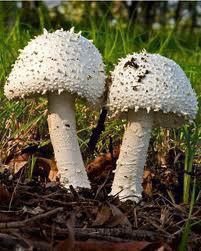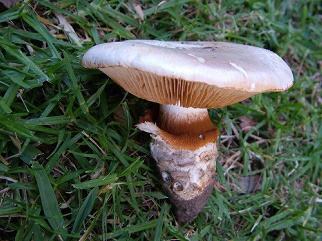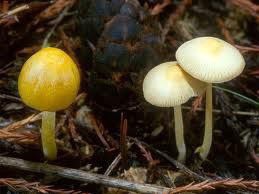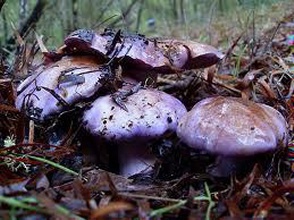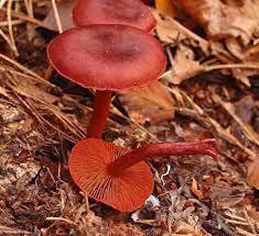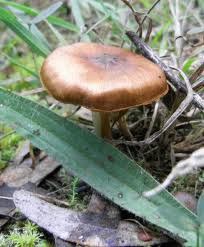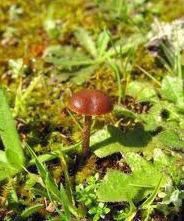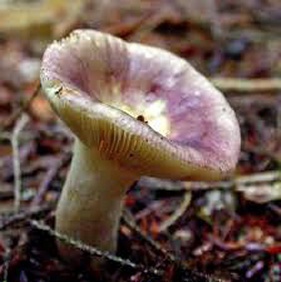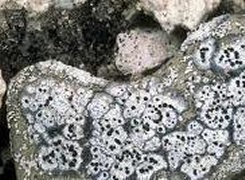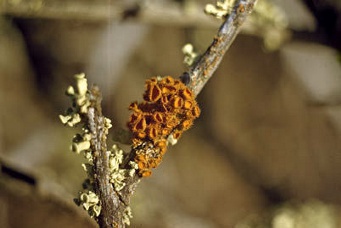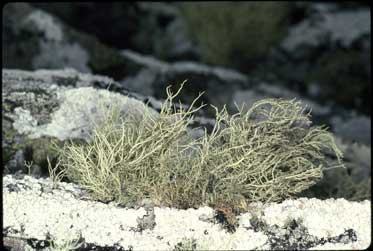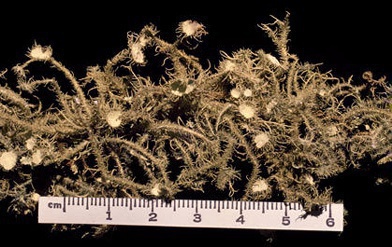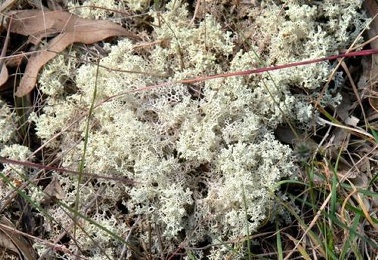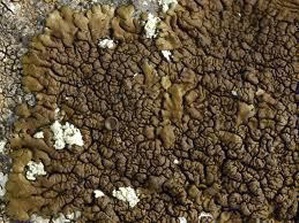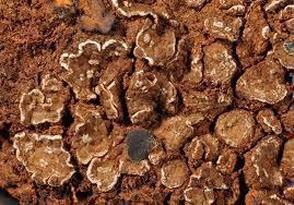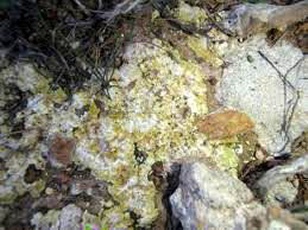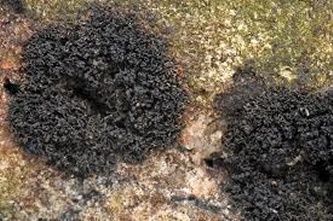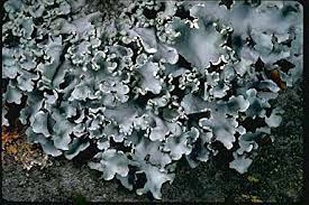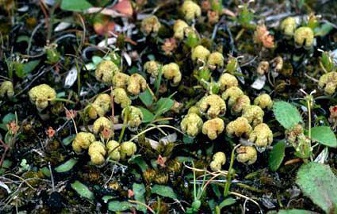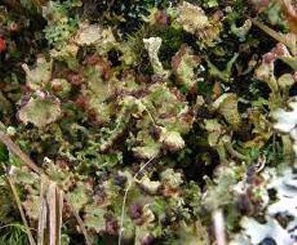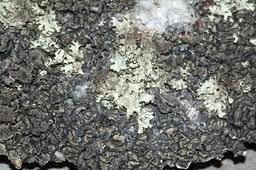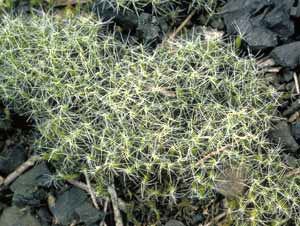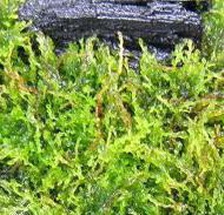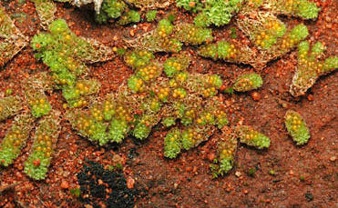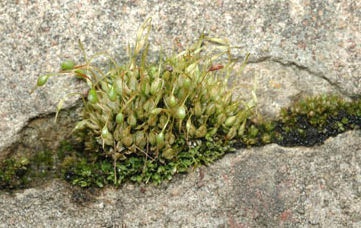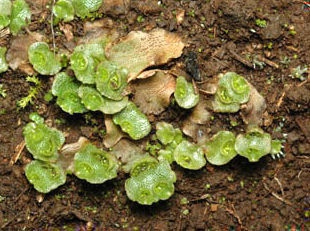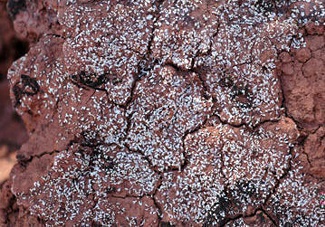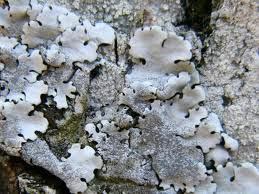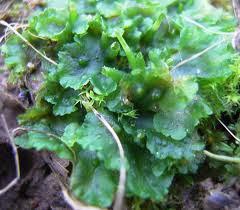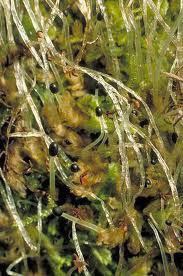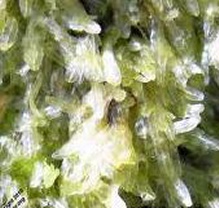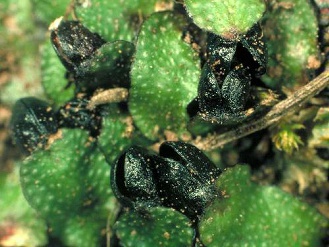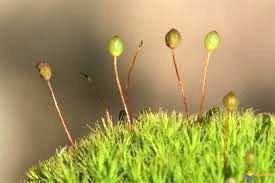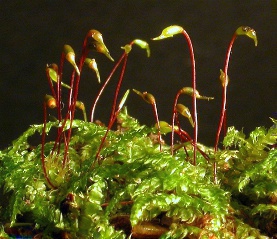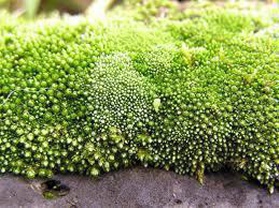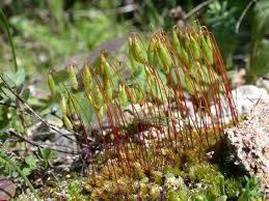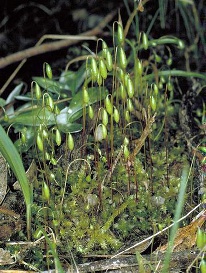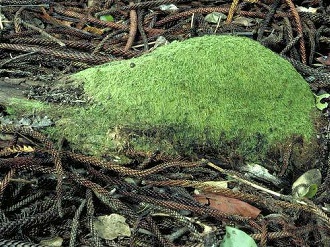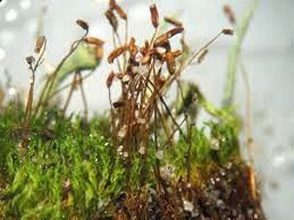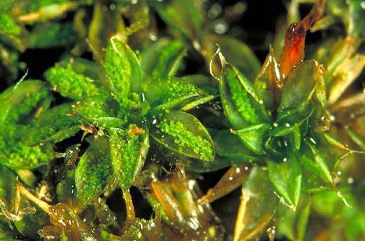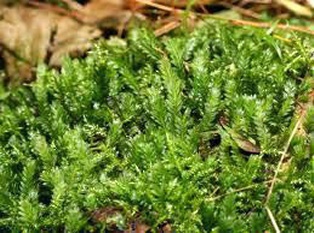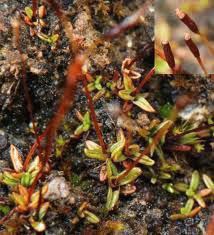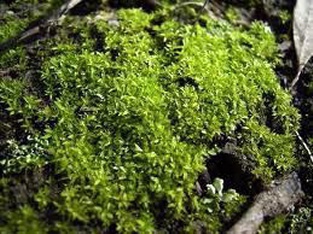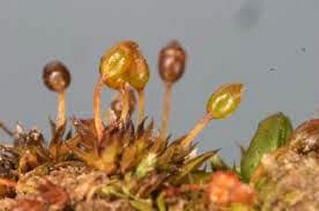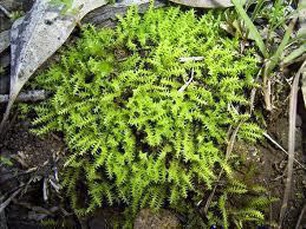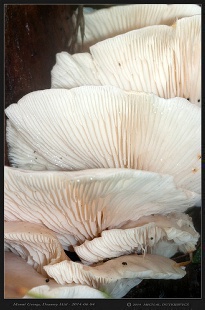What Plant Is That?
Fungi / Lichens
Liverworts and
Mosses
Clathraceae
Aseroe rubra
4-8 pairs of arms to 8cm long, emerging from a
purple 3cm egg-like stage. Grows in native forest,
woody or almond chips.
blueswami.com
Calostomataceae
Calostoma fuscum
To 3cm diametre, stem to 6cm long, exposed cap has an
opening with 4-7 raised scarlet rays.
Grows on clay soils.
blueswami.com
Dacrymycetaceae
Calocera sp.
blueswami.com
Agaricaceae
Agaricus vinacea
Cap to 10cm diam. Covered with fine fibres, stem to
9cm long.
Grows among debris in eucalypt forests.
Photo J Wamsley
Amanitaceae
Amanita xanthocephala
Cap to 3cm diam, striate margin with yellow-whitish
warts, stem to 4cm long 1cm thick. Often solitary on
the ground in native forests.
Amanita sp.
J Wamsley
J Wamsley
Boletaceae
Boletellus obscurecoccineus
Cap to 6cm diam, spongy below, stem to 10cm long.
On the ground in native forests.
Cortinariaceae
Cortinarius archeri
Cap to 9cm diam, violet at first, later becoming dry and
tan. On the ground in native forests.
Dermocybe austrovenetus
Cap to 8cm diam, stem to 8cm long, rather stout,
hollow. In groups on the ground in native forests.
Bankeraceae
Phellodon niger
Cap to 3cm diam, tough spongy below. Stem 2.5cm
long to 3mm diam. Firmly attaches to dead wood.
blueswami.com
blueswami.com
Podoscyphaceae
Podoscypha petalodes
Stem to 9cm high, 1-4cm wide, tough, leathery. Grows
at base of tree trunks and on buried roots.
blueswami.com
Ramariaceae
Ramaria sp.
To 15cm high and broad resembling a
cauliflower. On the ground in forests.
Ramaria sp.
To 15cm high and broad resembling a
cauliflower. On the ground in forests.
blueswami.com
blueswami.com
Russulaceae
Russula mariae
Cap to 8cm diam, stem to 6cm long and 2cm thick. On
the ground in native forests.
blueswami.com
Stemonitaceae
Stemonitis sp.
To 1cm high. Crowded, readily broken up by moving
air. On decaying wood.
blueswami.com
Stereaceae
Bracket fungus
Stereum illudens
To 10cm wide with edges upturned, upper surface hairy
toward the edges. Occurs as single or numerous
brackets on dead wood.
blueswami.com
Teloschistaceae
Teloschistes sp.
Disc like fruiting bodies. Grows on trees and bushes.
blueswami.com
Tricholomataceae
Dictyopanus pusillum
Cap 3-5mm diam edge incurving with pores below
stem lateral, 1-2mm long. In large groups often on
dead wood or trunks.
blueswami.com
blueswami.com
Mycena subcapillaris
Cap very small, to 5mm diam, grooved. Stem to 5cm
long, very slender. In groups on dead leaves and twigs
and among moss.
blueswami.com
Tricholoma coarctatum
Cap to 6cm diam, very irregular. Stem to 4cm long. In
groups under eucalyptus partially buried in soil.
Xerulaceae
Xerula radicata
Cap to 7.5cm diam, stem to 20cm long. Solitary or in
groups on soil and often on leaf litter in eucalypt
forests.
References used;-
PRESCOTT, A. [1988]. It's Blue with Five Petals. Wildflowers of the Adelaide Region. Openbook publishers, Prospect.
DASHORST, G. and JESSOP, J. [1990]. Plants of the Adelaide Plains and Hills. Kangaroo Press, Adelaide.
CRONIN, L. Australian Wildflowers Keyguide. [2000] revised edition Envirobook. Annandale NSW.
If you know that I have made any errors identifying any of the plants shown please let me know so I can correct them.
I am not a botanist and am happy to be corrected.
Also, feel free to contribute any of your own photos of plants and their identity. Thanks, Nita
.
Cortinarius cinnamoneus
Cap to 10cm diam. On the ground in native forests.
J Wamsley
Fold Mushroom
Agaricus campestris
Cap to 12cm diam. Stems to 8cm.
Grows aon the ground in fields and along roadsides.
Tremellaceae
rhizopogon sp.
More or less spherical to 5cm diam., with white strands. In
groups partially buried in soil and litter beneath pine
trees. Probably introduced.
Calocera sinensis
To 2cm high, cylindric, sticky. Grows together in large
numbers on rotting wood.
Clavariaceae
Clavulinopsis amoena
To 4cm high, segments to 4mm thick. On the
ground among leafy liverworts and pines.
Strophariaceae
Melanotus hepatochrous
Cap to 2.5cm diam., stem short, curved.
Grows on eucalyptus trunks.
Omphalina ericetorum
Cap to 2cm diam, margin finely grooved. Stem to 2cm
long. In groups on the ground.
Omphalina chromacea
Cap to 2cm diam. Stem to 2cm long. In groups on
bare ground or in low moss.
Hygrophoraceae
Camarophyllus niveus
Cap to 2cm diam., Stem to 4cm high. Grows on the
ground under conifers.
Cortinarius subarcheri
Cap to 8.7cm diam, sometimes irregular. On leaf litter
under eucalypt forests.
Cortinarius sublargis.
Cap to 9cm diam, covered with small fibres and
furrows. Grows in sandy soil often in recently burnt
country.
Collybia elegans
Cap to 5cm diam., slightly velvety. Stem to 6cm long. In
groups among leaf litter or on rotten wood.
Psilocybe subaeruginosa
Cap to 5cm diam. Stem to 10cm long. Solitary or in
groups on soil or leaf litter in eucalypt forests.
Mycena vinacea
Cap to 3cm diam. Stem to 7cm long. In clusters on
fallen wood, stumps and among leaf litter in forests.
Marasmius crinis-equi
Cap to 4mm diam., flesh very thin. Stem to 2.5 -14cm
long. In groups on plant debris in forests.
Amanita grossa
Cap to 18cm diam, cap with scattered warts which
are often pointed. Stem to 15cm long. On the ground
in groups in native forest, has strong rancid or sour
smell.
Amanita grisea
Cap to 10cm diam, stem to 13cm long 1-2cm thick.
On the ground near Eucalyptus rubida
Gymnopilus sp.
Cap to 12cm diam. Grows on stumps and dead
wood.
Cortinarius australiensis
Cap to 18cm diam, stem to 15cm. Grows on the
ground in eucalypt forest.
Judith Glover
Cortinarius sp
Cap to 7cm diam, stem to 7cm. Grows on the ground
in native forest.
Bolbitiaceae
Bolbitius vitellinus
Cap to 5cm diam, slimy, grooved and often split. Stem
to 10cm long. Grows among grass.
Cortinarius lavendulensis
Cap to 9cm diam, stem to 2cm thick. Grows under
bushes.
Cortinarius sanguineus
Cap to 4cm diam, smooth with edges often slightly
grooved. Grows on the ground in native forests.
Psilocybe sp
Cap to 3cm diam. Stem to 4cm long. Grows on the
ground. Probably introduced.
Russula persanguinea
Cap to 7cm diam, stem to 9cm long and 1cm thick. On
the ground in native forests.
Lichens
Physciaceae
Buellia subalbula
Forms a thin pale grey layer mainly on limestone,
fruiting bodies black.
Teloschistes chrysophthalmus
Orange to greyish orange, to 2cm across. Fruiting
bodies to 6mm across. Grows on trees and
bushes.
M Fagg
Usneaceae
Usnea inermis
1-5cm tall. Grows on trees and bushes.
M Fagg
Usnea scabrida
1-5cm tall. Grows on trees and bushes.
J Elix
Cladoniaceae
Cladia ferdinandii
Lace like plant to 10cm tall. Grows on soil.
Andy Down Under
Cladia aggregata
To 8cm tall. Grows on soil.
Heterodeaceae
Heterodea muelleri
Leaf like plant to 10cm across.
Parmeliaceae
Neofuscelia pulla
Leaf like plant olive brown to yellowish brown.
Grows on soil and rocks.
Lecideaceae
Eremastrella crystallifera
Forms a scaly grey to brown layer on soil.
Fulgensia subbracteata
The plant can be white to orangish and 1-2cm
in diameter.
Lichinaceae
Lichina confinis
Plant olive green to black to 1cm tall.
Parmotrema chinense
Leaf like plant that is always blue grey.
Pseudocyphellaria neglecta
Leaf like plant to 12cm across.
Lobariaceae
Psora decipiens
Scale like pinkish plant grows on soil.
Ramalinaceae
Ramalina celastri
Plants to 8cm tall. Grows on trees and bushes.
Liverworts
Aytoniaceae
Asterella drummondii
Grows on soil
B Fubher
Cladonia cervicornis
Plant to 14cm tall. Usually grows on soil.
Xanthoria ligulata
To 8cm across. Grows on rocks and trees.
Xanthoparmelia tasmanica
Leaf like, yellow green or blackening. Usually
grows on rocks.
Mosses
Dicranaceae
Campylopus introflexus
Leafy stems to 3cm tall.
Cephaloziellaceae
Cephaloziella exiliflora
Often grows on burnt wood.
Codoniaceae
Fossombronia sp.
Grows mainly on soils.
M Fagg
Funaria hygrometrica
Leafy stems to 2.5mm tall.
M Fagg
Funariaceae
Marchantiaceae
Lunularia cruciata
Grows on soil and is common in gardens.
M Fagg
Polytrichum juniperinum
Leafy stems to 10cm tall.
M Fagg
Polytrichaceae
Ricciaceae
Riccia sp
Lobes of plant 1 to 6mm wide. Grows on soil.
M Fagg
Parmotrema pruinata
Leaf like plant, greyish. Grows on trees and
bushes.
Anthocerotaceae
Anthoceros laevis
Grows on soil
Geocalycaceae
Lophocolea semiteres
Most commonly grows on fallen logs.
Metzgeria decipiens
Grows on tree trunks.
Metzgeriaceae
Targionia lorbeeriana
Grows on soil.
H Lepp
Targioniaceae
Bartramiaceae
Bartramia stricta
Leafy stems to 1.5cm tall.
Rhynchostegium tenuifolium
Leafy stems prostrate to 8cm long.
D Tng
Brachytheciaceae
Bryaceae
Bryum argenteum
Leafy stems usually less than 1.5cm tall.
Bryum torquescens
Leafy stems to 2.5cm tall.
Bryum sp.
Leafy stems usually less than 1cm tall.
D Tng
Hypnum cupressiforme
Robust leafy stems 5-10cm long, party prostrate.
M Fagg
Hypnaceae
Ditrichaceae
Ceratodon purpureus
Leafy stems to 5-15mm tall.
Pottiaceae
Tortula papillosa
Leafy stems usually 7-8mm tall.
H Lepp
Fissidentaceae
Fissidens sp.
Aloina ambigua
Leafy stems to 2mm tall.
Barbula calvcina
Leafy stems to 3cm tall
Pottia davalliana
Leafy stems to 3mm tall.
Triquetrella papillata
Leafy stems to 2-4cm long.
Thuidium furfurosum
Leafy stems creeping, to 10cm long.
Thuidiaceae
Marasmiaceae
Omphalotus nidiformis aka Ghost Fungus
Stem usually hidden behind other tops in their crowded bunch,
feeding on dead or dying wood, usually at the base of trees

